Standards English Version
The following are symbols of CE and EN
standards which are commonly found on protective Clothing.
|
Symbol
|
Content
|
|
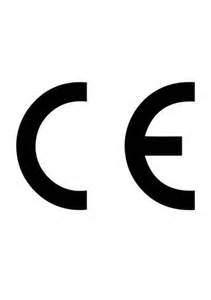
|
CE marking is a mandatory conformity
marking for certain products sold within the European Economic Area (EEA).It is manufacturer's declaration that the product meets the
requirements of the applicable EC directives. It states that the product is
assessed before being placed on the market and meets EU safety, health and
environmental protection requirements.
|

|
EN 343 Water-resistant protective
clothing
This is a standard for water-resistant
protective clothing, including materials and stitching, and is divided into
two parts.
1. Water penetration (shown at the top of
the label)
2. Resistance to water vapor (show on the
bottom of the label)
For 1. Water penetration standards. It is
divided into three levels of water pressure requirements
- Level 3 ≥13000 Pa
- Level 2 ≥8000 Pa
- Level 1 same as Level 2 but
no pre-treatment
For 2. Water vapor degree (RET), lower
level represents a higher permeability.
- Level 1: RET≥40
- Level 2: 20
- Level 3: RET≤20
|
|

|
EN388 Protective gloves against
mechanical risks
This standard applies to gloves that
protect against physical and mechanical hazards. It specifies requirements
for abrasion resistance, perforation resistance, tear resistance and cutting
resistance.
The minimum requirements are listed
on the following table.
|
Characteristics
|
Level
1
|
Level
2
|
Level 3
|
Level 4
|
Level 5
|
|
abrasion
resistance (number of cycles)
|
100
|
500
|
2000
|
8000
|
-
|
|
Cutting
|
1.2
|
2.5
|
5.0
|
10.0
|
20.0
|
|
Tear
resistance ( in Newton)
|
10
|
25
|
50
|
75
|
-
|
|
Perforation
resistance (in Newton)
|
20
|
60
|
100
|
150
|
-
|
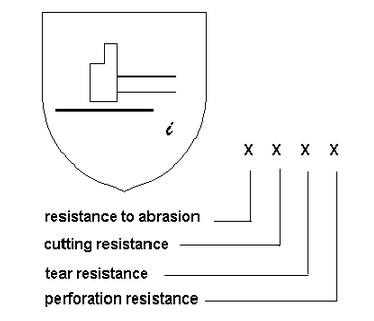
Pictograms
|

|
EN469
Fire coats and fire trousers
To meet the standard 2005, the following requirements should be fulfilled.
1. Standard 6.2 within reach compliance with Level 2.
2. Standard 6.3 within reach compliance with Level 2.
3. Standard 6.6.1 within reach accord ≥1500N.
4. Standard 6.7 within reach accord ≥150N.
5. Standard 6.11 within reach compliance with Level 2.
6. Standard 6.12 within reach accord
|
|

|
EN471-High Visibility warning clothes.
This standard states
the requirements for clothing capable of notifying the user's visual presence.
The required performance includes color and retro reflection, minimum areas
and disposition of the materials.
The performance is
divided into 3 different classes (class 3 is the highest).
|
Class 1
|
Total fluorescent
area must be at least 0.14 m² and 0.10 m² reflective materials.
|
|
Class 2
|
Total fluorescent
area must be at least 0.5 m² and 0.13 m² reflective materials.
|
|
Class 3
|
Total fluorescent
area must be at least 0.8 m² and 0.2 m² reflective materials.
|
|
|
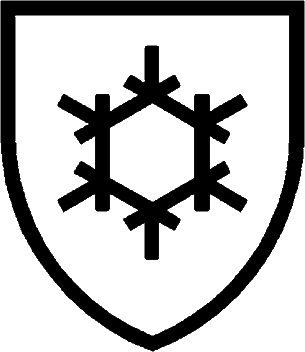
|
EN 511-Protective gloves against
cold
This standard specifies the
characteristics and test methods for protective gloves against cold
transmitted by convection or conduction to a temperature of -50°C.
Requirements:
1. The protective
gloves have to comply with the general requirements for protective gloves
EN420 with respect to size designation and pH
2. Abrasion
resistance and tear strength resistance shall meet at least level 1 (EN388)
3. The coating of
the glove shall withstand repeated flexing (ISO 7854:1984) (no bursts after
1000 cycles)
4. If required the
glove shall be impermeable to water for >30 minutes (test method for leather
shoes)
5. The cold
resistance (ISO 4675:1990) at a temperature of -50°C. No bursts at the
location of the folds.
6. Convective
cold: The thermic isolation is measured with a heated artificial hand. The
heat loss is used as a measure for the thermal insulation of the glove.
|
Level of Performance
|
Thermic Insulation (m2.°C/W)
|
|
1
|
0.10 £ Itr ³ 0.15
|
|
2
|
0.15 £ Itr ³ 0.22
|
|
3
|
0.22 £ Itr ³ 0.30
|
|
4
|
0.30 £ Itr
|
7. Conductive cold
(contact) (ISO 5085-1:1989) : the resistance to heat loss (in m2.C°/W) at a
specified pressure (6.9 kPa) is used as a measure for the insulation against
conductive cold. Four levels of performance are defined.
|
Level of Performance
|
Thermic Insulation (m2.°C/W)
|
|
1
|
0.025 £ R ³ 0.050
|
|
2
|
0.050 £ R ³ 0.100
|
|
3
|
0.100 £ R ³ 0.150
|
|
4
|
0.150£R
|
|
|
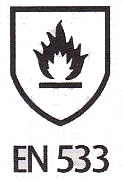
|
EN533-Protective against heat and
flame(Limited flame spread materials and materials assemblies)
The standard specifies the performance requirements for limited
flame
spread materials and materials and materials assemblies used in
protective clothing. This standard covers requirements for
resistance to
flame spread materials or raw materials suits. This standard is
the most
direct method for testing flame spread of flame. The test consists
of 10
seconds as a standard. Propane gas is applied to fixed length
(50mm)
test materials directly.
Material flame spreading resistance performance
before and after washing is classified as different indices.
|
1
|
When the test
is completed, any remaining flames and testing of fabric composed of hole
must not be in contact with the edge of the fabric and must not contain any
residues.
|
|
2
|
Same as 1,
but without the formation of holes in the tissue composition
|
|
3
|
Similar to 2,
but when the flame is extinguished, the flame on the fabric must be stopped
within two seconds and with EN533 as a test material. Besides, it consists
of test for washing several times (uses ISO 10528: 1995 as the standard).
As for drying, it uses ISO 6330: 1984 as standard. The number of washing
and the washing temperature is also included in report.
|
|
|

|
EN 11611(EN470-1)
This
standard specifies minimum basic safety requirements and test methods for
protective clothing including hoods, aprons, sleeves which as are used to
protect the wearer's body including head and feet and that are worn during
welding and allied processes with comparable risks. It indicates that
garments meet the requirements for limited flame spread for surface and
bottom-edge ignition.
Clothing
for welding protection is classified into two types.
1. Manual welding techniques with light formation of splatters
and drops.
2. Manual welding techniques with heavy formation of splatters
and drops.
|

|
EN 11612
This standard describes work wear operating
under high temperature environment which protect workers from flammability.
Such clothing can be divided into:
|
A
|
Limited spread of fire
|
|
A1
|
Surface lighting
|
|
A2
|
Bottom lighting
|
|
B
|
Convection heat
|
|
C
|
Radiant heat
|
|
D
|
Molten Aluminum Splash
|
|
E
|
Molten Iron Splash
|
|
F
|
Conduction Heat
|
|
|

|
EN
1149-Electrostatic properties
This
Standard specifies material and design requirements for electrostatic dissipative
protective clothing which is used as part of a total earthed system to avoid
incendiary discharges.
The
material should meet requirements of EN 1149-1 (Surface resistance) or 1149-3
(Induction charging). *The requirements may not be sufficient in oxygen
enriched flammable atmospheres. This European Standard is not applicable for
protection against mains voltages.
Anti-static material should meet at least one of the following
requirements.
1. t50 <4 or="" s=""> 0.2 (Testing
requirements according to standard EN1149-3: 2004, Test Method 2-inductive
charging method.)
2. A surface resistance of ≤ 2.5 * 109 ohms. If the
material comprising a conductive wire, the pitch of conductive yarns of
clothing contained in either direction should not be more than 10mm.
|
|
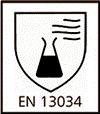
|
EN 13034 (2005)-Type 6 Protective
Clothing
This standard stated that chemical
protective suits (Type 6) should fulfill the following protective criteria
1. The standards must comply
with EN 340 (2003) which set out the general requirement of protective
clothing.
2. Materials testing requirements.
EN14325:2004 clearly states the testing requirements and the corresponding
specification.
|
Clauses in EN14325:2004
|
Testing requirements
|
Specifications
|
|
4.4
|
EN530 Abrasion Method 2
|
>10 cycles
|
|
4.7
|
EN ISO 9073-4 Trapezoidal tear
resistance
|
>10N
|
|
4.9
|
EN ISO 13934-1 Tensile Strength
|
>30N
|
|
4.10
|
EN863 Puncture Resistance
|
>5N
|
|
4.12
|
ISO 6530 (/ EN368) Repellency to liquids
|
>95%
|
|
4.13
|
ISO 6530 (/ EN368) Resistance to liquids
|
<5%
|
|
4.14
|
EN 13274-4 Resistance to ignition Method 3
|
5s
(Not continue to burn after 5s removal from flame)
|
3. Test requirements for seams,
joins & assemblages of Type 6 protective clothing.
a. Seams should be constructed
to minimize of prevent penetration of liquid through stitch holes or other
components of a seam.
b. Seam strength is determined
and classified in accordance with EN14325:2004, Clause 5.5 and must obtain at
least Class 1.
|
Clauses in EN14325:2004
|
Testing requirements
|
Specifications
|
|
5.5
|
EN ISO 13935-2 Method 2
|
>30N
|
c. Spray Test for Garment
|
Clauses in EN13034:2004
|
Testing requirements
|
Specifications
|
|
5.5
|
ISO 17491-4 (/ EN468) Spray Test Method A
|
Pass
|
|
|

|
EN14404
Knee-pad type is classified as follows:
|
Type 1
|
Kneepads independent of other clothing,
fastened around the legs.
|
|
Type 2
|
Knee pads in foam or other padding,
secured in pockets on the legs, or which is permanently attached to the
pants.
|
|
Type 3
|
Knee pads not attached to the body, but
placed in position as user moves around.
|
|
Type 4
|
Knee pads used as part of a unit with
additional functions, such as the framework for support to stand up, or
kneeling seat. Can be worn on the body, or be independent.
|
Knee protection class are classified as
follows:
|
Class 0
|
Flat floor surfaces
|
|
Class 1
|
Flat or uneven floor surfaces. Protects
against penetration by a force of at least (100 ± 5) N
|
|
Class 2
|
Flat or uneven floor surfaces under
severe conditions. Protects against penetration by a force of at least (250
± 10) N.
|
|













